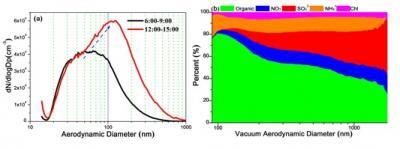Air pollution in China has exhibited noticeable changes over the past 30 years, shifting from point-source pollution (around factories and industrial plants) in the 1980s to urban pollution in the 1990s. Since the start of this century, air pollution has become increasingly regional and more complex. Recent research has indicated that the cooperative transition of SO2 and NOx into secondary aerosols (sulfate and nitrate) played a critical role in the haze pollution episode in China in January 2013.
The coexistence of high concentrations of primary and secondary gaseous and particulate pollutants results in numerous heterogeneous reactions occurring on the surfaces of fine particles. These reactions change the oxidizing capacity of the atmosphere, chemical compositions, and the physicochemical and optical properties of the particulate matter. The overall effect is that air pollution and haze formation is accelerated. It is, therefore, important to explore the formation mechanisms of secondary aerosols during air pollution episodes. The paper, "Mechanism for the formation of the January 2013 heavy haze pollution episode over central and eastern China", Science China: Earth Sciences, No. 1, 2014, by Professor Wang and co-workers shows that the formation of secondary sulfate aerosols from SO2 increases in the presence of NOx.
This study explores the cooperative transition of SO2 and NOx into secondary aerosols on the surfaces of carbon-containing particles through heterogeneous reactions. The formation of sulfates from SO2 is promoted by the existence of NOx. Results show that as the particle size increases, the fractional contributions of secondary inorganic ions, such as sulfate and nitrate, also increase (Figure 1). The hygroscopicity of the particles increase and the increased water content can accelerate the gas–liquid–solid reactions of SO2 and NOx, which further increases the hygroscopicity of the particles. These processes form a positive feedback mechanism that enhances the conversion of primary gas pollutants into secondary aerosols. Consequently, it is important to reduce emissions of the precursor gases of PM2.5 to reduce the overall PM2.5 concentrations in the atmosphere. The authors conclude that in central and eastern China, SO2 and NOx should be controlled synchronously to reduce PM2.5 concentrations.

This shows a) particle number size distributions and b) fractional contributions of organics, nitrate, sulfate, ammonium, and chloride to the PM1 mass during the haze episode from 06:00 to 15:00 LT, Jan. 12, 2013.
(Photo Credit: ©Science China Press)
Source: Science China Press